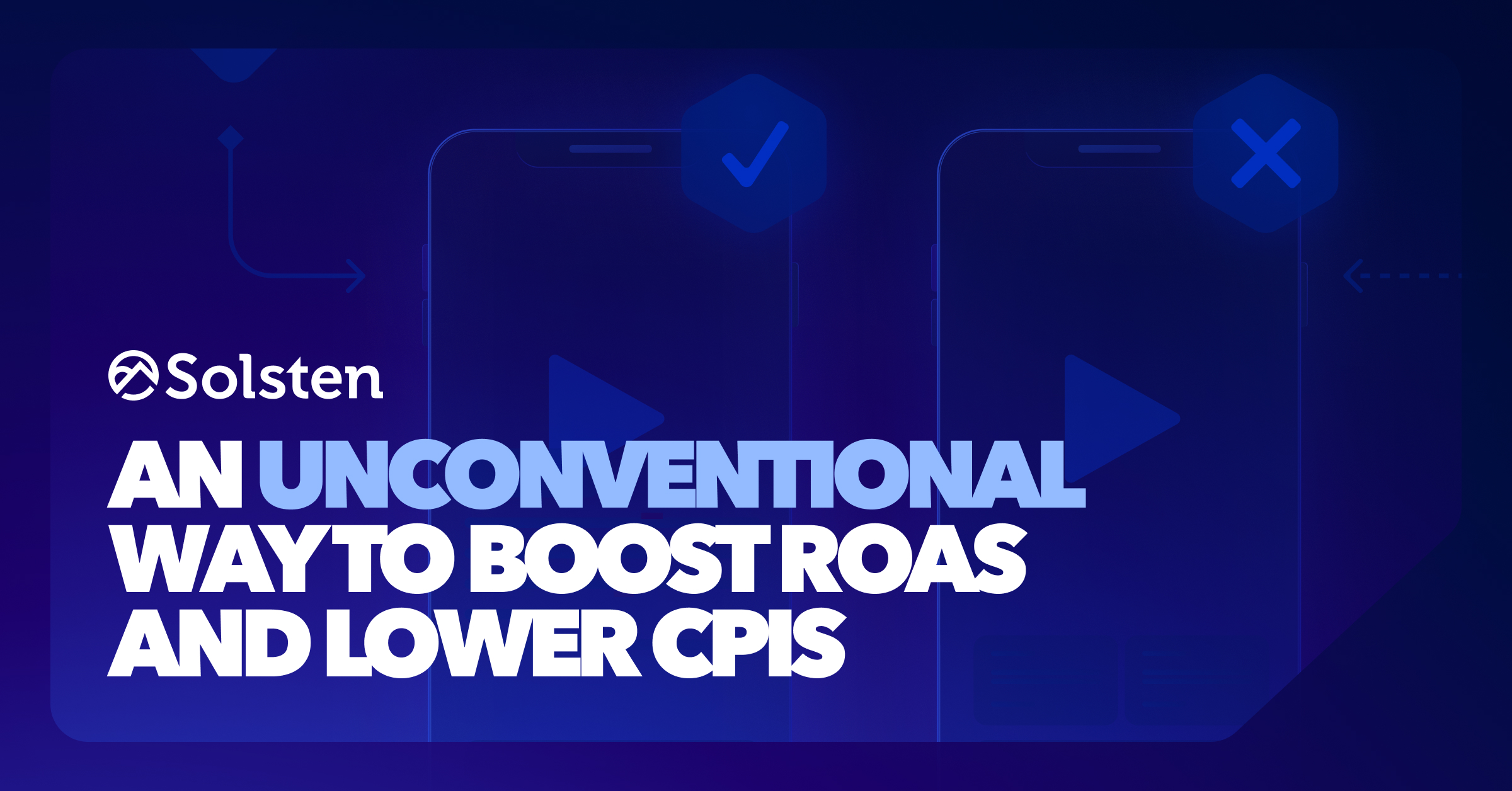If you’re marketing a video game, there are two metrics you’re measuring on a constant basis: cost per install (CPI) and return on ad spend (ROAS). These numbers determine whether your campaigns are succeeding or failing — and they’ve been stubborn over the last few years. This is mostly due to high competition, uncooperative partners, and new data privacy laws. Because of these challenges, marketing teams have been looking for new ways to improve both metrics, testing and optimizing their ads with increasingly sophisticated tools and tactics.
But what if this approach to improving these metrics was focusing on the wrong part of the process?
Yes, testing and optimizing ads are essential aspects of video game marketing. However, all of these tools and tactics come with one massive caveat: the results they produce can only be as good as the creative that is fed into them.
What this means is that with all the tech that exists to test and optimize ads, their results are still limited to the quality of the initial starting creative.
With the right creative assets, you can significantly reduce CPIs and increase your ROAS. In fact, Nielsen reports that compelling creative accounts for 86% of sales growth in digital advertising, with the quality of this content contributing to a 65% lift in digital ad sales. A MAGNA Media Study backs this up, attributing 56% of influence on consumer purchase decisions to the quality of creative content.
But the impact of creative goes beyond just these top-line numbers. Let’s take a look at how improving CPIs and ROAS is merely the beginning of what quality creative can achieve.
Break Through Your Local Maximum
What’s really holding your ad performance back, even with all this sophisticated technology? The most important reason to focus on the quality of your creative is that the right creative will help get you past your local maximum. In optimization, a local maximum refers to the best solution within a certain range of possibilities, but not necessarily the best solution overall. Think of it like climbing a mountain range — you might reach the top of one peak, but there could be even higher peaks elsewhere that you haven’t explored yet.
In the context of ad testing and optimization, your “local maximum” is the best performing ad within your current set of creative assets. A/B testing and dynamic creative optimization can help you identify this local maximum, but they won’t necessarily help you find an even better ad that’s outside of your current creative scope.
How can you break through this ceiling and reach entirely new levels of ad performance? This is where the quality of your creative inputs comes into play. If you’re only testing variations of the same basic ad concept, you’ll quickly hit a performance ceiling. No matter how much you optimize, you’ll be stuck at that local maximum.
But if you invest in developing a wide range of high-quality creative assets, you open up the possibility of finding an even higher peak — a global maximum that outperforms your previous best by a significant margin.
This is why relying solely on testing and optimization, without a parallel focus on creative quality and innovation, can limit your growth potential. The right creative assets don’t just incrementally improve your existing ads — they help you breakthrough to entirely new levels of performance.
Reduce Churn
The impact of creative goes beyond just CPI and ROAS. What if you could use your ads not just to drive installs, but to actively shape your player base?
The right creative attracts the right audience. Not all installs are created equal. Your ad creative plays a big role in attracting players who are the right fit for your game — whose motivations and preferences align with what your game has to offer.
By creating ads that speak directly to the core motivations of your target audience, you can make sure that the players you acquire are more likely to find value and enjoyment in your game, leading to higher engagement, retention, and lifetime value.
Video game marketers don’t always think this way. They think that as long as they can get a player into their game, that’s a win. After all, the game is excellent. People will want to play it. If you’re making console games with an up-front cost of $70, that may be true. As long as you’ve convinced a player to purchase your game, you’ve won. But if you’re working in the free to play space, this thinking couldn’t be more backwards.
Let’s look at this through the lens of another product — a candy bar, for example. What if your candy bar sales didn’t depend on people paying for the candy bar and then eating it. What if they got the bar for free, and only paid for it if they liked it. Wouldn’t you do everything you could to make sure only people who had a high probability of liking your candy bar would be the ones taking it off the shelf at the supermarket?
How can you make sure you’re attracting the right players, not just the most players? Following the logic of this metaphor, the right creative will filter out players who aren’t a great fit for your game. This raises your ROI by making sure you don’t bring players into your game who have a high probability to churn.
Increases Retention and Engagement
Creative sets the right expectations for your game. Think of these ads as the first step in your first time user experience (FTUE). If they are misleading, exaggerated, or disconnected from the actual gameplay experience, players will quickly become frustrated and churn out.
When your ads showcase what your game is all about — the key features, the gameplay, the emotional outcomes — then the players who download it are more likely to enjoy the experience and stick around for the long run.
On the other hand, testing creative that doesn’t resonate with your audience can have significant negative consequences that go beyond poor ad performance. This all takes time, money, and talent. The wrong creative will lead wasted resources and opportunity costs, can damage your studio’s brand perception, and will make it exceedingly difficult to scale and optimize.
Build Brand Affinity
But what about the bigger picture? How can your ad creative contribute to your studio’s long-term success?
The right creative builds brand equity and affinity. Your ad creative is not just a tool for driving immediate installs — it’s also an opportunity to build long-term brand equity and affinity with your target audience. Every impression, click, and install is a chance to create a positive association with your game and studio.
By consistently delivering high-quality, authentic, and resonant ad experiences, you can cultivate a sense of trust, loyalty, and enthusiasm among your player base that extends far beyond any single campaign or creative execution.
Drive Long-Term Profitability
Finally, engaging and resonant ad creative optimizes for long-term profitability. Ultimately, the success of your game depends on your ability to acquire players efficiently and monetize them effectively over time. Your ad creative is a key lever in this equation, as it directly impacts the quality and value of the players you attract. By optimizing your creative for long-term metrics like retention, engagement, and lifetime value, you can ensure that your user acquisition efforts are not just driving volume, but actually contributing to the overall profitability and sustainability of your business.
Conclusion
In short, the ad creative you test and optimize is not just a means to an end — it’s a fundamental driver of your game’s success and a reflection of your brand and values as a studio. It’s the bridge between your game and your audience, and the key to unlocking the full potential of your marketing efforts.
So, what steps can you take to make your ad creative the driver of sustainable growth for your studio? The best marketing teams are tackling this question head on, predictably creating high-performing creative assets that reduce their CPIs and increase ROAS by understanding what creatives resonate best with their target audience.




